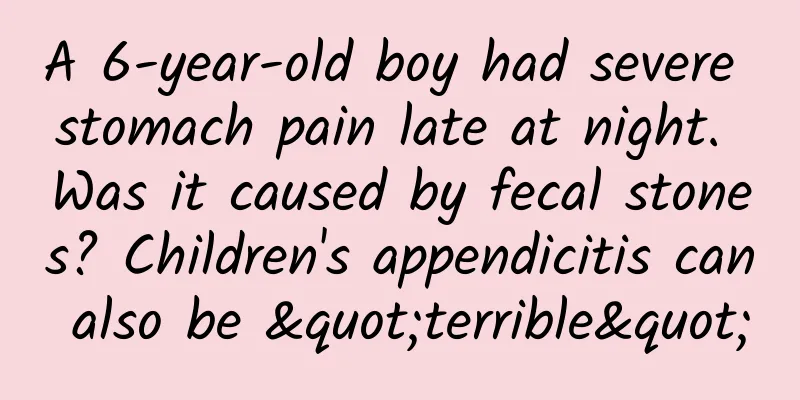A 6-year-old boy had severe stomach pain late at night. Was it caused by fecal stones? Children's appendicitis can also be "terrible"

|
Author: Feng Bing, Chief Physician, China Rehabilitation Research Center (Beijing Boai Hospital) Reviewer: Guo Yi, deputy chief physician, China Rehabilitation Research Center (Beijing Boai Hospital) Around 2 a.m. one day, a middle-aged man came to seek help anxiously holding his 6-year-old son. The boy suddenly had severe stomach pain and cried heartbreakingly. After a careful examination, the doctor found that there were many "fecal stones" in the boy's appendix, and the appendix was obviously swollen. Fortunately, the boy was sent to the hospital in time and did not suffer from serious complications such as perforation and abdominal infection. After active treatment, the boy has recovered and been discharged from the hospital. Figure 1 Copyright image, no permission to reprint 1. What is appendicitis? Can children also get it? Acute appendicitis is a common acute abdomen disease that can occur in both adults and children, and most cases occur in children between the ages of 5 and 12. When children develop appendicitis, they will experience severe abdominal pain, cry incessantly, and may refuse the doctor's palpation. Because children may not clearly describe the location and degree of pain, this often leads to delayed diagnosis. When children suffer from acute appendicitis, their anatomical structure is not fully developed, their appendix is relatively small, and their greater omentum is relatively short, lacking sufficient omentum barrier protection. Therefore, compared with adults, they are more susceptible to perforation, abdominal infection, and may even develop septic shock, which is life-threatening. The causes of appendicitis in children usually include multiple aspects: one is gastrointestinal dysfunction; the second is changes in dietary structure; the third is the presence of obstruction. In particular, children and adolescents are more likely to have fecal stone obstruction. When fecal stones block the appendix opening, it will cause increased pressure in the appendix and blood circulation obstruction, thus causing necrosis and infection of the appendix. There are many types of appendicitis in children, which can be divided into complicated appendicitis (including perforated appendicitis and gangrenous appendicitis) and simple appendicitis (including acute appendicitis and suppurative appendicitis) according to the presence or absence of appendicitis perforation and necrosis. What are the symptoms of appendicitis in children? How is it diagnosed? Common symptoms of appendicitis in children include abdominal pain, which may start around the navel and then gradually move to the lower right abdomen, accompanied by vomiting, diarrhea, and fever. During the diagnosis process, blood tests often show an increase in the number of white blood cells, an increase in the proportion of neutrophils, and an increase in the level of C-reactive protein; elevated procalcitonin plays an important role in distinguishing perforated and suppurative appendicitis from simple appendicitis. In addition, the neutrophil-to-lymphocyte ratio (NLR), as a new inflammatory indicator, has been considered an independent risk factor for complicated appendicitis. When NLR>11.74, the risk of complicated appendicitis is significantly increased [1]. Ultrasound examination is one of the preferred methods for diagnosing appendicitis in children due to its non-radiation characteristics. Since children have thin abdominal walls, ultrasound is more conducive to observing the condition of the appendix. Ultrasound manifestations are usually related to the pathological classification of the appendix: simple appendicitis is manifested as an enlarged appendix, usually with a diameter of more than 6 mm and no obvious exudate around it; suppurative appendicitis is manifested by ultrasound as a mixed echo mass, and the diameter of the appendix can swell to more than 15 mm; while gangrenous appendicitis is manifested by unclear appendix structure, obvious swelling, and exudate around it. CT examination can also provide valuable diagnostic information, showing swelling of the appendix, enlarged lumen, and blurred space around the appendix. If the appendix has become purulent, a mass can be seen on the CT image, with small bubbles or air-liquid planes inside, and high-density fecal stones. These fecal stones are mostly round, oval or strip-shaped, and are a mixture of bacteria, mucus and residues in the appendix cavity. Figure 2 Copyright image, no permission to reprint 3. How to treat appendicitis in children? Is surgery necessary? Appendicitis is an inflammatory process and not all cases require surgical removal. Simple appendicitis can be treated with antibiotics. However, if the appendix becomes necrotic or perforated, surgical treatment should be considered. In terms of the choice of surgical method, traditional laparotomy has been gradually replaced by minimally invasive laparoscopic surgery. Laparoscopic surgery has the advantages of less trauma, relatively beautiful incisions, and quick recovery, so it is more easily accepted by children and their families. There are also many ways of laparoscopic surgery. Among them, the traditional three-hole method is usually performed through the navel, left midabdomen, and pubic symphysis; while the single-hole method only opens a small hole in the navel, which is less traumatic and more minimally invasive, but this method has limited operating space and slightly poor flexibility. It is more suitable for the treatment of uncomplicated appendicitis and has higher technical requirements for the surgeon. If the exposure during the operation is difficult and the anatomy is complex, it may be necessary to add more holes. In addition, a new treatment method has emerged, namely, endoscopic retrograde treatment under X-ray or ultrasound guidance[2], which is specifically used to treat obstructive appendicitis caused by fecal stones in children. In this method, the doctor will insert a tube into the appendix cavity, flush, remove the stone, and insert a stent under endoscopy to eliminate the obstruction factor and relieve symptoms. This method can intuitively monitor the position of the guidewire, observe the flushing effect in real time, and check the recovery of the appendix. Figure 3 Copyright image, no permission to reprint 4. If a child has appendicitis, how should parents take care of him? When a child is diagnosed with appendicitis and requires surgery, parents’ worry and distress are inevitable, but knowing the correct care knowledge will help you take better care of your child. 1. Before surgery (1) Calm the child's emotions: Tell the child clearly and simply what will happen next, and let the child believe that the doctor and nurse will help him defeat the "sick monster". You can distract the child by telling stories, listening to music, or playing some simple games, while avoiding strenuous exercise and drastic emotional fluctuations. (2) Follow the doctor's instructions: Parents must strictly follow the doctor's and nurse's instructions to ensure that their children are fasting before surgery. Do not feed your child secretly because you feel sorry for your child, because fasting is required before anesthesia. It is extremely dangerous to feed your child without telling the doctor. 2. After surgery (1) Observe the wound: Pay close attention to the recovery of the wound. If you find any abnormal symptoms such as redness, swelling, heat or pain, you should inform your doctor immediately to prevent wound infection. (2) Pain management: Children may feel varying degrees of pain and discomfort after surgery. The doctor will use medication to relieve pain as appropriate. At the same time, parents should comfort their children, help them relax, and divert their attention appropriately to relieve pain. (3) Promote recovery: Encourage children to get out of bed and move around as soon as possible, which helps to restore intestinal function. When the doctor allows eating, they should start with light and easily digestible food, such as rice soup, and gradually transition to rice porridge, egg custard, soft noodles, etc., until they resume normal eating. In short, although appendicitis in children is dangerous, as long as it is diagnosed in time and receives the right treatment, the child can usually recover. Therefore, if your child has related symptoms, please go to a regular hospital for treatment in time. During the nursing process, the patience, care and correct nursing knowledge of parents will play a vital role in the child's recovery. References [1] Yu Qiang, Guo Zhengtuan, He Yingli, et al. Predictive value of neutrophil-to-lymphocyte ratio for the diagnosis of complicated appendicitis in children[J]. Chinese Journal of Evidence-Based Medicine, 2018, 18(10): 1027-31. [2] Guo Xiaoya, Yang Hengli, Li Jinghua, et al. Clinical value of high-frequency ultrasound and ultrasound contrast-enhanced endoscopic treatment of suppurative appendicitis caused by fecal stones in children[J]. Journal of Clinical Ultrasound in Medicine, 2024, 26(07): 564-8. |
<<: How to prevent osteoporosis
>>: Does a high-protein diet really damage your kidneys?
Recommend
What is the cause of increased leucorrhea after menopause?
In most cases, women generally do not have leucor...
Pain in the middle of the back after giving birth
The spine is made up of many different vertebrae,...
I haven't had my period for two months, what's going on?
Irregular menstruation is a symptom experienced b...
Is the residue from medical abortion high echo?
Medical abortion is a method of abortion that mor...
Tips for testing the gender of a baby one month into pregnancy
Today's smart technology is developing at a r...
How to treat a girl’s snoring?
Snoring is a common sleeping phenomenon. Currentl...
Does Clivia need sunlight? What is the reason why the leaves of Clivia become soft?
Clivia is a common green plant in the home. Somet...
How to supplement women's low hormones
If a woman's hormones are too low, it will hi...
Is superimposed infection terrible? Five common misunderstandings about respiratory diseases in one chart!
Recently, topics such as influenza, mycoplasma pn...
I get sick every time the holidays come. What’s wrong?
Another Spring Festival is here. During this joyo...
What to eat to replenish energy in the delivery room
Giving birth to a child is both painful and joyfu...
What does the dark area in the uterus mean on ultrasound?
Dear female friends, you must protect your uterus...
The menstrual period came and then stopped after a few drops of blood
Menstruation should come on time every month for ...
Can rosuvastatin be taken in pieces? My cholesterol is lower now and I don't want to take so many medicines.
A friend told Huazi that he had high blood pressu...
Why does a woman feel pain and itching in her vagina?
The female vagina is a reproductive organ that is...









